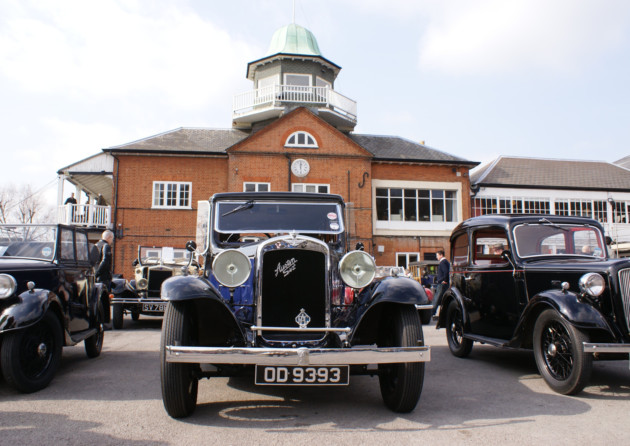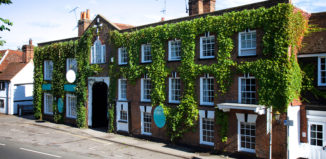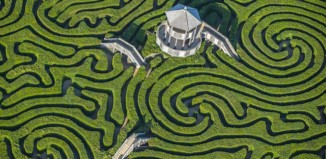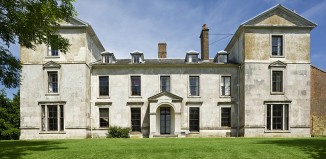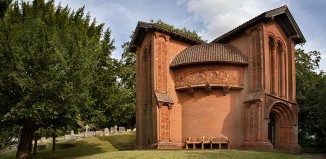Brooklands Museum
Vicky Sartain
In the heyday of Edwardian Britain, motor sport and aviation were grand passions for the dashing men and daredevil women who pushed the boundaries on the race track and in the skies. As engineering developments accelerated, so did those behind the wheel, and nowhere else in Britain saw such incredible skill and showmanship as at the Brooklands motor-racing circuit, which opened in 1907.
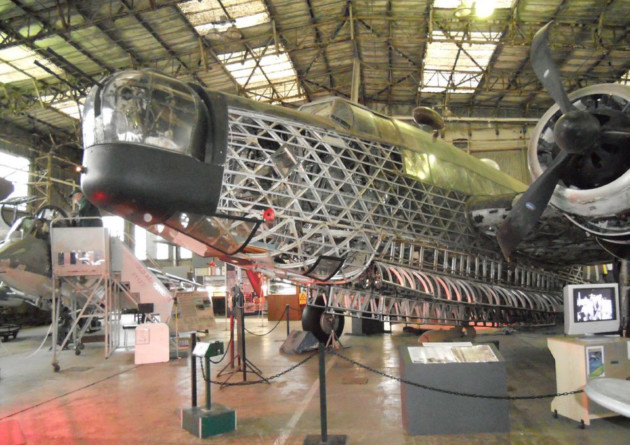
The brainchild of wealthy landowners, motoring enthusiasts Hugh and Ethel Locke King, the two and three-quarter mile track was in answer to the lack of similar racing venues in the UK. “Prior to Brooklands, anyone wishing to watch motorsport had to travel abroad to find equivalent excitement or to test their vehicles at high speed,” explains Marketing Manager Paul Stewart. “Inevitably, the couple’s 350-acre Surrey estate, deemed ideal for the project, was earmarked for development.” With a workforce of 1,500 the great oval track began to take shape. Concrete was chosen to cover the surface which featured two vast banked sections curving nearly 30ft high – allowing cars to maintain speed while cornering. At 100ft wide vast swathes of the landscape had to be cleared, but despite this, work took just nine months to complete. The world’s first purpose-built motor racing circuit was born.
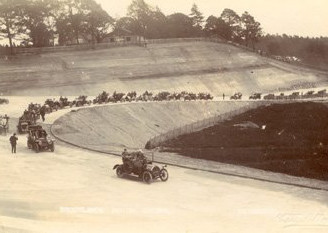
Although little of the track now remains, memories of its existence are all around at the museum which commemorates its pre-and postwar legacy. Stationed partly within the former race track clubhouse, which once offered members and their glamorous guests a billiard room, lounge and tea room among other civilised pursuits, the museum recalls the spirit of race day and spills through the doors into the various buildings of the 32-acre site.” Perhaps a surprising name to see among the exhibits is that of romantic novelist Dame Barbara Cartland, a Brooklands regular who was instrumental in creating a ladies’ reading room in the 1930s. “One of the starlets of the time was Kay Peter, a successful female driver,” says Paul Stewart. “The first women’s motor race was held in 1908 – years before women were even allowed the vote!” Among their male counterparts, it was Sir Malcolm Campbell who broke many Land-Speed records and drove the famous Blue Bird, a highlight of the Campbell Shed where the legendary driver and his team would tune and test their cars between 1926 and 1935. Today, visitors can complete their own circuit through some of the world record-breaking vehicles and racing club memorabilia displayed here.
In 1926 the first British Grand Prix was staged at Brooklands, and 16 February 2013 marked the centenary of the first man ever to travel 100 miles in an hour in a Talbot car, driven by Percy Lambert.
The infamous ‘Brooklands bump’ was an unfortunate feature of the track, which had a tendency to launch a vehicle into the air on impact. An archive image of the airborne Napier-Railton can be seen, driven by John Cobb, in 1935. This prized vehicle is still in operation today. Beneath the bonnet sits a 24 litre aeroplane engine which allowed it to reach 143mph, in appearance more like a speeding silver bullet than a car. “It’s something of a celebrity even now, having appeared in various films, and still travels the world to make appearances,” says Paul.
Neighbouring this are exhibits of bicycles, from penny farthings to the latest Raleighs – many of the earliest bicycles on display were once raced around the track in exhilarating competitions – a reminder of the popularity of cycling during a period when it was a necessary pursuit. “If you could not afford a motor car, cycling was the next best option and many of Brooklands top employees – even aviators – relied on their bicycles to get them to work,” explains Paul.
While vintage vehicles are the undoubted stars of the show, the legacy of decades of aviation cannot be ignored. While the automobile was the initial crowd-puller, early aviation companies had noticed the advantages of stationing themselves at Brooklands, which offered an ideal environment for developing their planes within the safety of the track boundary. Sheds were turned into makeshift hangars at the Byfleet end of the site, and some of the greatest names in aviation such as Tommy Sopwith and Harry Hawker learned to fly here. No slouches in climbing into the cockpit, women were taking to the air too, with the first female pilot’s licence issued to Hilda Hewlett in 1910. The onset of the First World War in 1914 would pause the trackside excitement – automobile, motorcycle and cycling – but aircraft production soared, with Brooklands becoming the largest military aircraft manufacturing centre in the country.
Various flying clubs were established at Brooklands and after the First World War it was the place to see aerobatics of the day. Airborne Gipsy and Tiger Moths were a familiar sight and the public came from far and wide to enjoy the spectacle of flying displays and open days; the antics of the aviators inspired the 1965 comedy film, Those Magnificent Men and their Flying Machines. An Art Deco flight school building became the hub for pilots as the Clubhouse was for motorists, though it no longer survives from the era, swept away for modern development.
“Every vehicle and aircraft seen here has a connection with Brooklands’ history,” explains Paul. “We want to tell the story of how important the site was, and keep our exhibits relevant to that story.” From the earliest AV Roe-built biplanes, apparently held together with little more than a piece of string, sticks and brown paper to the streamlined Concorde (available to board – its nose cone and tail were built at Brooklands), engineering marvels and miracles can be witnessed beneath one roof, documenting the pace of aviation through each decade.
The Vickers factory established operations here, producing the Wellington bomber, and as the hangar centrepiece, the skeletal frame of this historic aircraft can be enjoyed at close range. Some 2,515 of these huge twin-engined bombers were built at Brooklands – one of these which ditched in Loch Ness during a training flight in 1940 was fished from the deep in 1985 and returned, finally, to base. Carefully restored all bar its propellers, which remain artily twisted from impact with the loch, visitors can see the inner workings of the plane as they walk beneath its wings or peer inside the cockpit. To the rear of the hangar it is possible to experience the cramped conditions of the aircraft on a replica of the Wellington interior. Climb inside and imagine how Second World War pilots would have fared in such a vulnerable environment.
The victor of the Battle of Britain, the Hurricane was also assembled at Brooklands and test-flown from the airfield in 1935. Refining the aircraft to reach its battle prowess took place in the hands of Brooklands engineers. Perhaps the most famous of these was Sir Barnes Wallis who spent nearly 40 years at Brooklands, designing the Wellington aircraft and famed ‘bouncing’ bomb among other weapons of war – gravity defying, enormous cylindrical bombs – close enough to touch.
During the Second World War the racetrack was an obvious target for the Luftwaffe and it became necessary to rip up the concrete and disguise as far as possible. It was a sad moment for the Locke Kings and the nation, symbolising the end of the good times. Aircraft and weapon production continued here for the remainder of the conflict.
Plans are afoot, dependant on the outcome of an Heritage Lottery Fund bid, to restore the Wellington hangar. This will involve relocating the building to an appointed site, and turning it into an interactive visitor centre. “At the same time we want to restore the historic finish straight of the race track just in front of the Clubhouse, taking back to how it used to be,” adds Paul.
No day is ever the same at Brooklands. Exit the Clubhouse from the sounds of the Jazz Age to the roar of a throttle as a car pushing 100 years old is put through its paces on the test hill. Dressed for the part, drivers congregate to watch the action while awaiting their turn in their own vintage car. Some smoke pipes as they confer. It could be a scene from last century.
Brooklands Museum, Brooklands Road, Weybridge, Surrey KT13 0QN. Tel: 01932 857 381. www.brooklandsmusuem.com

